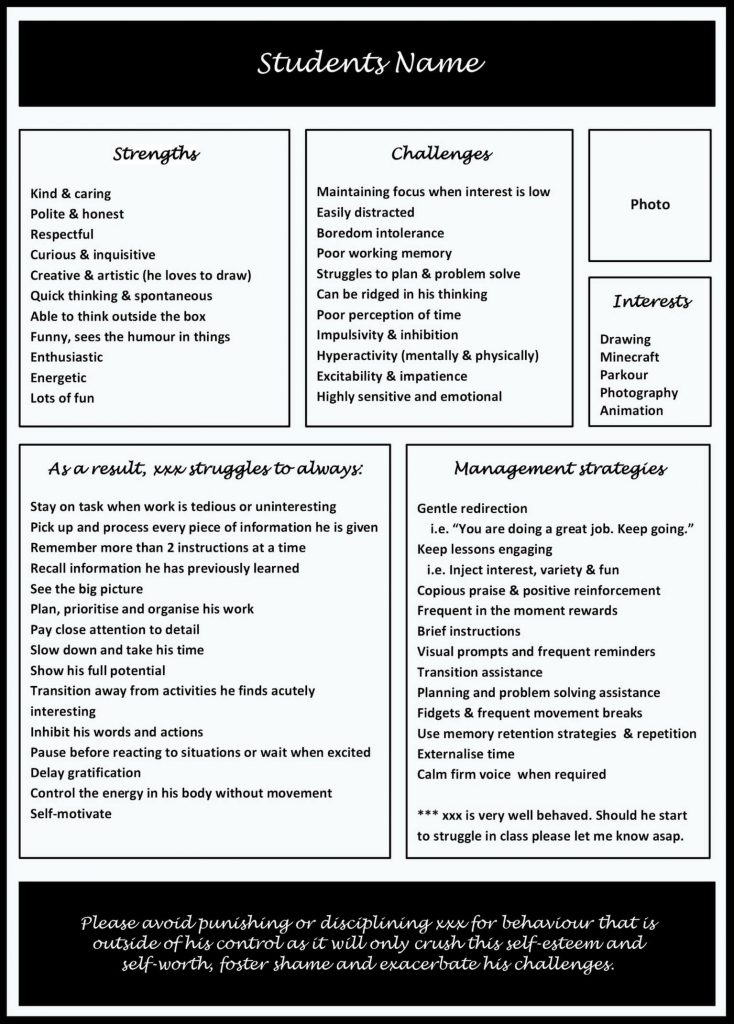
Back to school with ADHD: Fostering a team approach between teachers and parents
School can be very difficult for children with ADHD to negotiate. Symptoms of their condition can be challenging and they may find it hard to sit still, to focus and concentrate, to stay on track and to transition between tasks. They may struggle socially and display behaviour that is considered socially inappropriate. They also tend to underperform academically (regardless of their actual ability) – the Australian child and adolescent survey of mental health and wellbeing (2015) found 50% of students with ADHD achieved less than the national minimum standard during NAPLAN testing.
It is important for parents to know that teachers often receive little education and training around ADHD. This lack of training adds to the struggles children with ADHD experience because of their condition as often teachers do not have a good understanding of the symptoms and challenging behaviours ADHD can produce, nor the underlying reasons for them. This is very concerning as the explanation a teacher attributes to a student’s challenging behaviour greatly influences how they perceive the student. It also influences the choice they make between implementing classroom accommodations to support the student, or engaging behaviour management interventions to discipline them.
ADHD symptoms often manifest in ways that are confusing and confronting. Without a real understanding of why a student with ADHD presents as they do, it is easy for teachers to jump to the conclusion that any negative or challenging behaviour they display is intentional on their part. That is, teachers may mistakenly conclude that a student with ADHD is choosing to act in a manner that is annoying, time-consuming, rude or naughty in order to manipulate or upset them or their fellow students, or they may conclude that the student is lazy or unmotivated and therefore needs a ‘good kick up the bum’, instead of realising that the behaviour the child is displaying is an expression of ADHD symptoms and is therefore beyond the child’s control.
Unfortunately, misinterpretation of ADHD symptoms increases the chance teachers will resort to disciplinary interventions as a way of controlling children with ADHD. This can have devastating outcomes as discipline will not rectify any of these challenges. However the child is not giving the teacher a hard time, they are having a hard time. Punishing students for behaviour that is a symptom of their developmental delay and lagging self-regulation skills will only crush their self-esteem, self-worth and love for learning. It will also foster shame and exacerbate their challenges and can result in them becoming oppositional and defiant.
Children with ADHD tend to do best when their teachers put in place scaffolding that either mitigates their challenges or bridges the gap between their lagging executive function skills and the expectations placed upon all students in the classroom. They also respond well to receiving copious in-the-moment praise and acknowledgement. And it is of great benefit when teachers listen with empathy to students with ADHD, as well as collaborate with them when making decisions around supportive interventions, as these actions can help to gently foster personal self-awareness and the development of self-regulatory skills in the child. Scaffolding should be implemented in a way that does not draw attention to the child, thereby protecting their fragile self-esteem.
So, whilst ADHD advocacy groups campaign for the implementation of high-quality teacher education and training, as a parent of a child with ADHD how can you hand over your child to their new teacher in a way that fosters open communication and a collaborative approach to supporting your child in the classroom? And how can you help to improve the teacher’s knowledge and awareness around ADHD without offending them?
Here are some ideas to consider:
- In the first few days of school, touch base with your child’s new teacher. Using a friendly and calm tone, very briefly let him or her know that your child has ADHD and that you would like to arrange a parent-teacher meeting. If the teacher requests more information, briefly state you would appreciate the opportunity to talk to him or her about your child and how to best support them in the classroom.
- Prepare for your parent-teacher meeting by creating a simple one-page handover sheet that explains your child’s strengths and challenges, as well as outlines the type of strategies that tend to work best with your child. You will find an example of a handover sheet below or you can download a PDF version here.

- Consider giving your child’s teacher a copy of the guide ADHD in Primary School. The guide has been written to assist teachers really understand ADHD and how to best support students with the disorder. Before you give the guide to your child’s teacher, however, make sure you read it yourself. By doing so you will also gain a better understanding of your child’s ADHD and the type of classroom support they require. You can purchase a copy of the guide here.
- Partner with your child’s teacher and offer to help them in any way you can. This may include working together to problem solve any issues that arise, helping them to understand the reasons behind a challenge your child is having, purchasing rewards for incentives, assisting with learning outcomes, etc.
- Check-in with your child’s teacher each day until you both feel your child has settled in or whenever concerns arise. This can be done using a simple thumbs up or thumbs down signal, with thumbs down indicating that it might be a good idea if you both have a chat.
It is important to remember that you also play a part in ensuring your child with ADHD is successful at school. Here are some home-based interventions that can assist your child to navigate school successfully:
- Establish simple and predictable routines at home to help your child get ready for school on time, as well as to complete their homework. For example, you could teach your child to lay out their clothes for the next morning before going to bed, to keep their school bag and schools supplies in a set place and to do their homework at the same time every day, etc.
- Make sure your own expectations of your child are appropriate for his or her executive function age (rather than their actual age) and put in place strategies that will help them succeed. For example, if your child has poor working memory and therefore forgets the steps involved in getting ready for school (even after the millionth time) consider collaborating with your child to develop visual prompts that will help support their memory. If your child needs assistance staying motivated when completing homework, provide copious praise and attempt to make their homework interesting. If your child struggles to break school work down into manageable pieces or cannot keep track of assignments, work with them to develop a plan of action or help them to use a diary. Please do not expect your child to be self-sufficient in any of these tasks in the short term – they may not develop the executive function skills they need to manage these things independently until they are much older. For general information about setting realistic rules and expectations, please click here.
- Listen with empathy to your child when they are struggling so they feel heard and understood. Listening with empathy helps your child to process their emotions and to think more clearly. It can also open up teachable moments and increase the chance of your child happily collaborating with you to identify preventative or management strategies they can experiment with in the future. For more information about listening with empathy please click here.
- Ensure your child eats a healthy diet, exercises and gets enough sleep.
- Slowly help your child develop the knowledge and skills they need to advocate for themselves.




Add A Comment